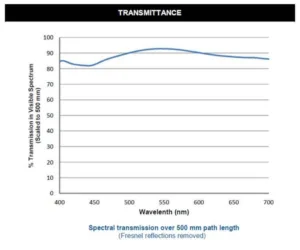Earlier this year Corning released a new glass type called Iris. We have reported on this new material before but at the time Corning only released general goals and the name of the new material. Now the company has released the data sheet.
First of all Corning is promising better colour performance based on a lower colour shift that is achieved by a higher internal transmission of the material compared to alternatives. The following curve shows the internal transmission for Iris glass (Fresnel reflections were removed) for a material thickness of 500mm. As a reference, Corning expects a panel thickness of 2mm being used in TVs but, with edge-lit designs, the optical path is much longer, affecting the spectral distribution of the light leaving the glass.
The other properties described in the material data sheet are as follows:
| Corning’s Iris Glass | |
|---|---|
| Properties | Specification |
| Dimensions | Up to 70″ |
| Dimensional Tolerance | +/-0.5mm |
| Thickness | 0.7mm, 1.1mm, 1.5mm, 2mm |
| Thicknes Tolerance | <0.1mm |
| Edge | Ra <=0.2µm |
| Surface Criteria | No visible defect using 600 lux |
| Properties | |
| Density | 2.4g/cm³ |
| Young’s Modulus | >68GPa |
| Refractive Index (633nm) | 1.49 |
| CTE | <80 x 10-7/° |
| Moisture Absorption | <0.001% |
| Source: Corning | |
| Corning’s Iris Glass – Thermal | |||
|---|---|---|---|
| Temperature (°C) | Specific Heat (J/g-K) | Thermal Diffusivity (cm²/sec) | Thermal Conductivity (W/cm-K) |
| 50 | 0.88 | 0.0056 | 0.012 |
| 102 | 0.93 | 0.0056 | 0.012 |
One important difference between Iris glass and PMMA is the Young’s Modulus, that is much higher for Iris. This allows for the use of thinner material and thus enables the slimmer TV design that Corning proposes.
Corning also released a video that shows the two main features as advantages for use in TV light guides.
As shown in the video, thinner TV designs and better color reproduction are the main arguments for using Corning’s Iris glass versus other materials. As Corning points out, it is now offering glass solutions for all parts of a TV. By weight, one could argue that TVs using Iris glass are mostly a Corning product if they also use Corning substrates for the other glass plates. – NH

